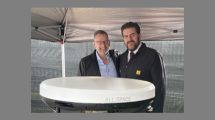 O3b was a concept that was conceived in Rwanda seven years ago by Greg Wyler, the founder of the company. Wyler helped to create Africa’s first commercial 3G mobile and fibre-to-the-home (FTTH) network and in 2008 was ranked amongst the top 50 global technology trendsetters. He felt the need for Africa to have proper infrastructural communication as a vital means to advance economically, socially and across the spectrum. The company is dedicated to proliferation of broadband and internet coverage combining the reach of satellite with the speed of fibre.
O3b was a concept that was conceived in Rwanda seven years ago by Greg Wyler, the founder of the company. Wyler helped to create Africa’s first commercial 3G mobile and fibre-to-the-home (FTTH) network and in 2008 was ranked amongst the top 50 global technology trendsetters. He felt the need for Africa to have proper infrastructural communication as a vital means to advance economically, socially and across the spectrum. The company is dedicated to proliferation of broadband and internet coverage combining the reach of satellite with the speed of fibre.
It wasn’t long before Wyler realised that a dire lack of communication is not just limited to Africa, but that the situation is the same in Latin America, the Pacific Islands, Asia and the Middle East. This is when he decided to do something about it and the concept of affordable high quality satellite broadband was created. How to get there was the trick. Wyler and his colleagues put a plan together, and over the years, a lot of time and effort has gone into developing the concept and sharing it with potential funding entities.
Mohamed Sadek, Managing Director of O3b, Middle East and Central Africa speaks about how the company managed to garner the capital for its ambitious project: “Google, HSBC and SES, one of the largest satellite operators with 56 satellites, are among our shareholders. The idea took hold because it advocates a noble cause. The very name O3b bears the essence of the company – the other three billion.
“We strive to provide high quality affordable communication infrastructure to the other three billion who are under-served, underprivileged and have been deprived from services. Some of our customers have never seen the internet and have never known the internet as you and I do. They have never heard of YouTube, because geo-satellites do not lend themselves to the delay it has, to streaming videos of any kind,” explains Sadek.
O3b has developed and engineered four satellites that it launched last year, and started offering limited service to customers, given that the constellation requires a minimum of eight satellites to complete the defined geographical area of coverage. The satellites were manufactured by Thales and launched from the Arianespace Centre in French Guiana.
Each satellite has 12 antennas, two for communications with O3b’s gateways, and 10 for its customer capacity services. Hence, each satellite can land 10 beams to O3b’s customers. Each beam is 700 km in diameter and can produce throughput up to 1.2 Gbps. The satellites are positioned in O3b’s Medium Earth Orbit (MEO) at a distance of 8000 km from earth allowing for very low latency that compares to that of fibre, hence delivering a much higher quality of service to customers.
“Customers that have been provided with our services are absolutely mesmerised by the quality of the service that they have been receiving, and have gone out and been vocal about it. The Royal Caribbean cruise liners tested our services, and loved it,” says Sadek.
“Telecom Cook Islands is live on the O3b service, and the CEO, Jules Mahar called it ‘historic’. This is amazing evidence of the quality of service we are able to provide. When we say fibre speed, we mean it, and it’s witnessed by our customers,” he adds.
On 10 July 2014, O3b launched the second set of satellites into its Medium Earth Orbit completing the constellation requirement for geographical coverage. Sadek says there will be a couple of weeks of In Orbit Testing (IOT) followed by ground tests where O3b will start switching on its customers around the world.
He explains that satellite communication is absolutely essential for remote areas with no fibre links.
“Throughput for our customer base is exactly what they need, be it for remote education in rural villages, e-health where there can be an exchange of X-rays and MRIs in regions where people are unable to get proper healthcare services. For communications in enterprises, like the energy sector, which is one of our biggest draws, whether for offshore or onshore rigs, they are in most cases in rural and remote areas with improper broadband service, so we bring that to them. Here in the Middle East, we are finding very strong traction as we are introducing our services to our customers,” says Sadek.
When asked about where he sees the business growing, Sadek explains that O3b is signing the most of the contracts in Asia-Pacific, and the Pacific regions. He attributes this adoption purely to the nature of the islands.
“There are so many of them, and they are so isolated, so for them O3b comes as a perfect solution. Our prices are extremely competitive with geo-satellite services by far. The combination of our high-quality throughput at affordable prices is very hard to get. Hence we’re very pleased that we can cater to this segment. In Africa and Latin America too, O3b is growing very strongly. We have landed many of our beams already and provided services to our customers. Some of them are large-scale deals,” explains Sadek.
He adds: “Government is a very important market segment for us, along with telecom operators, MNOs and ISPs. We do not cater to end-users per say, but rather to enterprises, carriers, governments and mobile operators.
“Up until last year we were selling our services on the basis of a PowerPoint slide and sales material. There was nothing to show for as the satellites were on the ground being manufactured and what we had was just our commitment and sales brochures, but we were able to sell and sign a lot of contracts purely based on this. Now that we have our satellites in space, I think it’s going to be much more exciting,” continues Sadek.
The Medium Earth Orbit brings latency down to a fraction of what it is today, eliminating any delay in communication. Customers can stream videos and browse the internet, download large data files, and use real-time applications that could not previously be used on geostationary satellite links. Fire alarms and disaster recovery, even security sensitive real time applications are now easily accessible. This is opening the doors to a host of businesses and services that were previously not possible.
According to Sadek, O3b has defined some sectors as early adopters: “The reason they want to use our services is because of the absolute need. There is no alternative. Remote and isolated islands are part of this. We are also seeing significant growth, albeit at a slower pace in the energy sector. These companies like to examine our services on a trial basis, and send their engineers and technicians to verify and perform tests. We have complied and have begun to see a very solid pattern of growth in the enterprise and energy markets.
Here in the Middle East, energy plays a major role because there are a lot of oil and gas resources in the region, so it is very important for us,” comments Sadek.
Furthermore, telecom operators in countries that have terrain which makes it difficult to deploy fibre links due to it being prohibitively expensive, prefer satellite links like O3b with fibre quality service.
“We are noticing that these mobile operators, through universal services funds and requirements are able to reach out to remote villages and towns that are beyond mountains, and provide the residents with services. Nowadays, everyone wants a smart device in their hands, whether they are in a fishing village, or an island, or in agricultural terrain. Operators think the Average Revenue per User (ARPU) is low and it won’t be adopted, but what we’re witnessing is a spike in data usage, when you provide services to these towns. People just jump on to them, and it’s not just teenagers on social networking sites, its farmers who use these smart devices to spare themselves a trip to the bank; to get a receipt or to meet a business colleague. They now do these transactions right from their homes as opposed to getting on a mule and travelling for miles. It is actually changing lives and facilitating commerce,” says Sadek.
The management of O3b sees the business growing by leaps and bounds, and believe that this truly is the future of satellites.
Sadek says SES recognised this early on and became a keen partner of O3b.
“This is a time to celebrate a major milestone in our journey. We intend to launch another set of four satellites by the end of this year, reaching a total of 12 satellites in orbit, as our constellation continues to grow.
“We will continue to launch satellites as long as the demand for our services is growing, but it’s also a time to take O3b to markets that we cater to and I believe our job is going to be easier as people learn more about us and our services,” concludes Sadek.












Add Comment